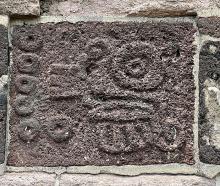tonalpohualli (Mglb11v)
This iconographic detail from the Codex Magliabechi shows four day signs (simplex glyphs) from the tonalpohualli, a 260-day calendar, with associated numbers (in notation). These signs include the tecpatl (flint knife), quiyahuitl (rain), xochitl (flower), and cipactli (crocodile). Each of these signs, as is typical, has a changeable companion number, one through four, respectively, in this case. The notation is shown as circles. The one is a blue circle with a red dot in the middle. The two involves two yellow circles with red dots in the middle. The three is blue again, and the four is yellow, and all the circles have red dots. Each sign is painted in a colorful way. The rain sign coincides with a representation of the sacred force or spirit of rain (Tlaloc), with his starry eye and blue swirling cloud forms around his eye and over his mouth (with many fangs). Spiky points cover the outside of the head of the cipactli. The flower has a red and white bow at its base. A similar bow is tied around the middle of the flint, and each one red and white, divided on an angle. The flint also has a face in profile, looking toward the viewer's left. The eye is what's called a starry or stellar eye (given that it can also serve as a star in the night sky), and it has a turquoise blue brow. Fangs protrude from its mouth. The texts below each day sign are in Nahuatl and Spanish.
Stephanie Wood
See William L. Barnes' explanation of the two Aztec calendars (the tonalpohualli and the xiuhpohualli, counts of the days and the years, respectively) in his article published by Mexicolore, https://www.mexicolore.co.uk/aztecs/calendar/the-aztec-or-central-mexica.... The calendars played a significant role in Nahuas' religious views of the cosmos.
Note the crocodile on the right. This compares favorably to the drawing by John Montgomery in the FAMSI collection. But a quick search for cipactli in this digital collection will show a large range of glyphs of crocodiles. Most of them, admittedly, are from the Matrícula de Huexotzinco (as of June 2025), and perhaps the tlacuilos of that area had trouble remembering the original cipactli glyph that was used in earlier manuscripts.
Stephanie Wood
between 1529 and 1553
Stephanie Wood
pedernales, lluvia, flores, caimanes, lengua bifurcada, colmillos, días, fechas, calendarios, cipac, xiuhpohualli, año, turquesa, xihuitl
This example of a carved stone hieroglyph representing the date Chicuace Quiyahuitl (Six Rain or 6-Rain) is found on the Templo Calendárico at the Tlatelolco archaeological site. Note how this rain glyph is represented by the divine force of rain, Tlaloc, which is also the case in the glyph for Two Rain (or 2-Rain), above. Other glyphs for rain show streams of water with droplets at the end. Photo by R. Haskett, 2 May 2025.
tonalpohual(li), count of days, https://nahuatl.wired-humanities.org/content/tonalpohualli
tecpa(tl), flint knife, https://nahuatl.wired-humanities.org/content/tecpatl
quiyahui(tl), rain, https://nahuatl.wired-humanities.org/content/quiyahuitl
xochi(tl), flower, https://nahuatl.wired-humanities.org/content/xochitl
cipac(tli), crocodile or caiman, https://nahuatl.wired-humanities.org/content/cipactli
la cuenta de los días
Stephanie Wood
The Codex Magliabechi (or Magliabechiano), a page published by Wikipedia, from folio 11 verso, https://en.wikipedia.org/wiki/Codex_Magliabechiano#/media/File:Codex_Mag...
(public domain image)

